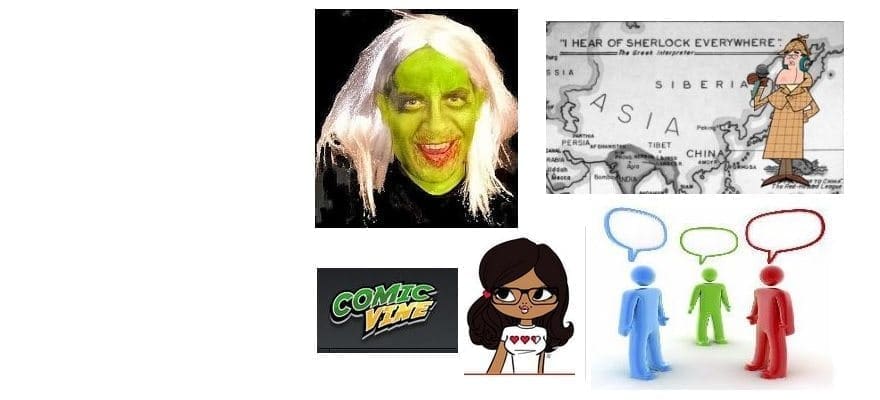There’s no doubt we’re in the middle of a geek renaissance. Signs of a massive geek rising abound.
Hacking is the new civil disobedience. Facebook memes of scientists Neal DeGrasse Tyson and Carl Sagan instantly go viral. The Bruce D. Nesbitt African-American Cultural Center sponsored a “Black Geek Week” that celebrated academic achievements in the black community.
Comic book heroes take up ever-larger chunks of blockbuster revenues with each passing summer. Dungeons & Dragons sessions are emerging from basements and kitchens and being held in increasingly public venues.
Comic book conventions are no longer a gathering of devoted fans or a niche demographic, but draw in wider audiences that may not cosplay, but are rediscovering their love of the genre nevertheless.
Best of all, reading, a formerly a nerdy/geeky activity, is now decidedly cool. Even better, books by geeks, for geeks (Geek-lit, if you will) are finally getting published and promoted! Deliciously nerdy gems that have languished in overstock piles are getting repackaged and reprinted to meet the new demand.
Here’s a list of geeky reads that will fascinate, settle debates (possibly), intrigue and amaze, all while building valuable geek cred.
 The Physics of Superheroes (Spectacular Second Edition) by James Kakalios
The Physics of Superheroes (Spectacular Second Edition) by James Kakalios
This engaging read with a self-explanatory title is everything it promises to be with a lot of fun rolled into the knowledge.
One of the many appealing facets of this book is that the most extensive math the reader is required to do is be able to add, subtract, multiply or divide both sides of an equation. Or not. Never having made it past Geometry myself, I still understood and thoroughly enjoyed this book.
Kakalios has a conversational, easy to read style and often cracks jokes during the narration, making the science in this book more accessible (though the physicists out there will undoubtedly appreciate parts of equations or expanded explanations the rest of us probably skim).
In addition to finally getting an answer to the “How does that work?” questions you may have about your beloved comic heroes, you’ll also likely find your world inadvertently expanding on a day-to-day basis. Mundane events are suddenly exciting, real-life examples of science you never knew was so cool!
For example, after reading this book, suddenly a pen rolling off your desk reminds you of the gravity that pushes against Superman’s body as he flies. (Be careful, however; your coworkers may not understand why you yell, “That’s so awesome!” after the pen clatters to the floor.)
One also does not have to be familiar with comic superheroes because Kakalios gives very good cursory overviews of the heroes, only spoiling major plot points when necessary.
Each chapter covers a different law of physics and, usually, a different superhero. Chapter Four, for example, is called “Flash Facts: Friction, Drag and Sound” and impulse and momentum are artfully covered in “The Day Gwen Stacy Died.”
In short, one could have zero interest or background in both physics and superhero comics and still understand and enjoy this book.
Written by Andre Bormanis, a NASA scientist who was also the consultant for Star Trek: Voyager, Star Trek: Deep Space Nine and several of the more recent Star Trek feature films, this book combines the fun of being a Trekkie with the sincere intellectual interest most geeks proudly possess.
The chapters are written as reports to Starfleet Headquarters and focus on individual episodes of the television shows, making it a great bathroom book for the casual reader. The science is adequately explored but doesn’t require the reader to be on NASA’s shortlist of consultants.
I don’t consider myself a Star Trek fan by any means, but spent four years in college dating a true Trekkie and often found myself flipping through this book and getting caught up in a chapter or two.
If nothing else, it gives the non-Trekkie benevolently attending a Star Trek marathon something else to think about during the show (though TNG is hard not get hooked on; it kind of grows on you like a tribble…).
It’s common geek knowledge that George Lucas is a student of history and drew on his interest in history and anthropology when creating his universe in a galaxy far, far away.
What is slightly less common knowledge is that Lucas, in collaboration with 12 historians, selected 12 essays explaining what real-life world history inspired various characters and societies in the Star Wars universe.
The Knights Templar, French Revolution (and resistance), the rise and fall of capitalistic empires, all that and more can be found in any basic history text-book. But it’s far more fun to learn by examining them through the lens of Star Wars.
Edited by Nancy R. Reagin and Janice Lidel, the book was produced officially in conjunction with Lucasfilm, giving it about as much fandom cred as a book in the Star Wars pantheon can have.
 Killing Monsters: Why Children Need Fantasy, Super Heroes, and Make-Believe Violence by Gerard Jones
Killing Monsters: Why Children Need Fantasy, Super Heroes, and Make-Believe Violence by Gerard Jones
In the interest of full disclosure, I should mention this book was used as a text-book for one of my media classes back when I earning my Mass Comm degree, around 2005.
That does not, however, make it any less of a geek must-read, particularly for gamers looking to add to their arsenal of reasons why playing video games can be good for you.
Jones’ writing style can get a bit preachy, but to be fair he’s arguing a pretty unpopular position that engenders visceral reactions from a pretty frightening demographic: concerned parents.
That being said, Jones extrapolates research of how and why people process media the way they do and then applies that information to how children develop their sense of self. His conclusion are often surprising and almost always riveting.
It is easy, after reading his description of a child who has been completely sheltered from media violence pretending a twig he picked up is a gun (much to his mother’s exasperation), to develop a new, more nuanced view of video games and violence in film and television.
But even if the reader’s initial outlook remains unchanged, they will still find this book an interesting, informative read with valuable insights into how pop culture is developed, marketed and ultimately received.
For film geeks, this wonderful book by the brilliant director who brought you 12 Angry Men, Dog Day Afternoon and The Verdict is an absolute must read. Actually, it’s a must-own, as you may find yourself re-watching old favorites and going back to the book because you have a better understanding of how, exactly, that beloved scene/costume/dialogue/setting was created.
Lumet tells the reader exactly how movies are made by taking them through it, from the first cold reading of the script by the actors, generally in a nondescript location, to the premier with all its pomp, glitz and glamour.
Everything, from securing locations to the cost of renting helicopters to what film filters are required during different times of day, is covered in such a way that the reader will never, ever watch a movie the same way again, no matter how many behind-the-scenes DVD vignettes they’ve watched.
Readers will also never again question why making movies like Iron Man 3 costs so much or why actors sometimes need one, if not three, assistants on the set.
Some of the chapters discussing film equipment or the business side of “the industry” can get a bit technical, but the book is well-organized enough that the reader can easily move along if they so choose and still have plenty to enjoy.
 Law and the Multiverse: Superheroes, supervillains, and the law
Law and the Multiverse: Superheroes, supervillains, and the law
For geeks who prefer blogs to books, this innovative blog explores the real-life legal issues, dilemmas and ramifications comic book heroes or villains would face in U.S. courtrooms for trying to save (or destroy) the world.
Posts are drawn from comic culture including books and movies. Topics range from Iron Man 3: Property Law and Medical Experimentation to The Courtroom Antics of Golden Age Green Lantern. Often, posts will answer reader questions about specific issues and plot lines and, sometimes, the law.
The blog takes itself seriously enough to be informative but balances that out with a genuine love of comics that shines through each entry.
In addition to being just plain fascinating, the blog is easily searchable should it be needed to settle legal or comic book debates. Law nerds can search by topic via a drop down menu (headings include Constitutional Law, Property Law, etc.) and the search box will likely take comic researchers to where they need to go.
Written by James Daily, a Missouri an intellectual property attorney registered to practice before the U.S. Patent and Trademark Office (kind of a superhero feat in the legal industry) and Ryan Davidson, an Indiana attorney who focuses primarily on insurance law, the blog is detailed enough to be a quick, general reference for a law student (how I found the blog) but written well enough to also be accessible to a general audience.
Recently the pair wrote a book inspired by the blog, The Law of Superheroes, published by Gotham books, that is now available to purchase.
[SlideDeck2 id=9535]





























